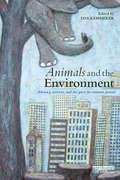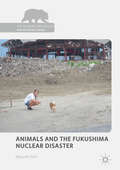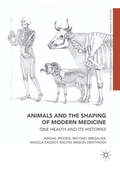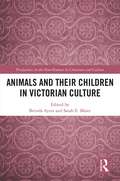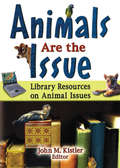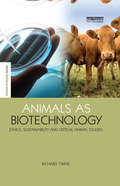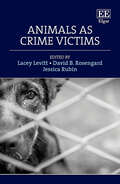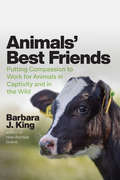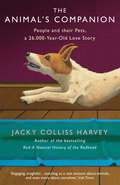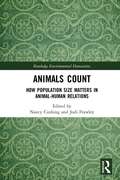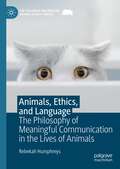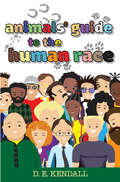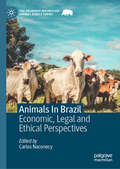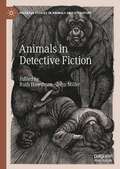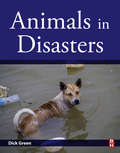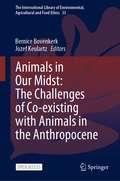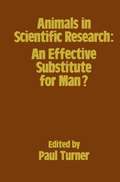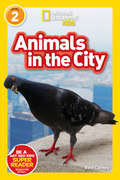- Table View
- List View
Animals and the Environment: Advocacy, activism, and the quest for common ground
by Lisa KemmererContemporary Earth and animal activists rarely collaborate, perhaps because environmentalists focus on species and ecosystems, while animal advocates look to the individual, and neither seems to have much respect for the other. This diverse collection of essays highlights common ground between earth and animal advocates, most notably the protection of wildlife and personal dietary choice. If earth and animal advocates move beyond philosophical differences and resultant divergent priorities, turning attention to shared goals, both will be more effective – and both animals and the environment will benefit. Given the undeniable seriousness of the environmental problems that we face, including climate change and species extinction, it is essential that activists join forces. Drawing on a wide range of issues and disciplines, ranging from wildlife management, hunting, and the work of NGOs to ethics, ecofeminism, religion and animal welfare, this volume provides a stimulating collection of ideas and challenges for anyone else who cares about the environment or animals.
Animals and the Fukushima Nuclear Disaster (The Palgrave Macmillan Animal Ethics Series)
by Mayumi ItohThis book is the first comprehensive, in-depth English language study of the animals that were left behind in the exclusion zone in the wake of the nuclear meltdown of three of the four reactors at the Fukushima Daiichi Nuclear Power Station in March 2011, triggered by the Great East Japan Earthquake of magnitude 9.0.The Japanese government designated an area of 20-kilometer radius from the nuclear power station as an exclusion zone and evacuated one hundred thousand residents, but left companion animals and livestock animals behind in the radioactive area. Consequently, about 90 percent of the animals in the exclusion zone died. This book juxtaposes policies of the Japanese government toward the animals in Fukushima with the actions of grassroots volunteer animal rescue groups that filled the void of the government.
Animals and the Shaping of Modern Medicine: One Health and its Histories
by Angela Cassidy Abigail Woods Michael Bresalier Rachel Mason DentingerThis book is open access under a CC BY 4.0 license.This book breaks new ground by situating animals and their diseases at the very heart of modern medicine. In demonstrating their historical significance as subjects and shapers of medicine, it offers important insights into past animal lives, and reveals that what we think of as ‘human’ medicine was in fact deeply zoological.Each chapter analyses an important episode in which animals changed and were changed by medicine. Ranging across the animal inhabitants of Britain’s zoos, sick sheep on Scottish farms, unproductive livestock in developing countries, and the tapeworms of California and Beirut, they illuminate the multi-species dimensions of modern medicine and its rich historical connections with biology, zoology, agriculture and veterinary medicine. The modern movement for One Health – whose history is also analyzed – is therefore revealed as just the latest attempt to improve health by working across species and disciplines. This book will appeal to historians of animals, science and medicine, to those involved in the promotion and practice of One Health today.
Animals and the Shaping of Modern Medicine: One Health and its Histories
by Abigail Woods Michael Bresalier Angela Cassidy Rachel Mason DentingerThis book is open access under a CC BY 4.0 license.This book breaks new ground by situating animals and their diseases at the very heart of modern medicine. In demonstrating their historical significance as subjects and shapers of medicine, it offers important insights into past animal lives, and reveals that what we think of as ‘human’ medicine was in fact deeply zoological.Each chapter analyses an important episode in which animals changed and were changed by medicine. Ranging across the animal inhabitants of Britain’s zoos, sick sheep on Scottish farms, unproductive livestock in developing countries, and the tapeworms of California and Beirut, they illuminate the multi-species dimensions of modern medicine and its rich historical connections with biology, zoology, agriculture and veterinary medicine. The modern movement for One Health – whose history is also analyzed – is therefore revealed as just the latest attempt to improve health by working across species and disciplines. This book will appeal to historians of animals, science and medicine, to those involved in the promotion and practice of One Health today.
Animals and Their Children in Victorian Culture (Perspectives on the Non-Human in Literature and Culture)
by Brenda Ayres Sarah Elizabeth MaierWhether a secularized morality, biblical worldview, or unstated set of mores, the Victorian period can and always will be distinguished from those before and after for its pervasive sense of the "proper way" of thinking, speaking, doing, and acting. Animals in literature taught Victorian children how to be behave. If you are a postmodern posthumanist, you might argue, "But the animals in literature did not write their own accounts." Animal characters may be the creations of writers’ imagination, but animals did and do exist in their own right, as did and do humans. The original essays in Animals and Their Children in Victorian explore the representation of animals in children’s literature by resisting an anthropomorphized perception of them. Instead of focusing on the domestication of animals, this book analyzes how animals in literature "civilize" children, teaching them how to get along with fellow creatures—both human and nonhuman.
Animals and Their Children in Victorian Culture (Perspectives on the Non-Human in Literature and Culture)
by Brenda Ayres Sarah Elizabeth MaierWhether a secularized morality, biblical worldview, or unstated set of mores, the Victorian period can and always will be distinguished from those before and after for its pervasive sense of the "proper way" of thinking, speaking, doing, and acting. Animals in literature taught Victorian children how to be behave. If you are a postmodern posthumanist, you might argue, "But the animals in literature did not write their own accounts." Animal characters may be the creations of writers’ imagination, but animals did and do exist in their own right, as did and do humans. The original essays in Animals and Their Children in Victorian explore the representation of animals in children’s literature by resisting an anthropomorphized perception of them. Instead of focusing on the domestication of animals, this book analyzes how animals in literature "civilize" children, teaching them how to get along with fellow creatures—both human and nonhuman.
Animals are the Issue: Library Resources on Animal Issues
by Linda S KatzSupply your library with the best collection of resources on animal issues! Animals are the Issue: Library Resources on Animal Issues is a guide to books, journals, and Web sites on historic and modern animal treatment. Expert librarians and scholars provide helpful resources showing what ideals and practical solutions exist in animal rights and welfare debates. With this book, students, philosophers, and politicians can find the best of written and electronic resources about the protection and ethical use of animals by humankind. Animals are the Issue stands alone as a source for locating materials on animal protection and welfare. This valuable guide will help librarians save time and money in locating diverse areas of information regarding animal consumption and exploitation. The authors have noted what they consider to be the most essential resources for library collections. This book offers references that discuss the utilization of animals by humans: as companions in sports and entertainment in religion in science and education in industry in hunting Animals Are the Issue explores how animals are seen, viewed, and used by humans. With bibliographies, annotated lists, and short commentaries by the authors on nearly every item, you&’ll be able to supply your patrons with a highly effective animal rights/welfare collection.
Animals are the Issue: Library Resources on Animal Issues
by Linda S KatzSupply your library with the best collection of resources on animal issues! Animals are the Issue: Library Resources on Animal Issues is a guide to books, journals, and Web sites on historic and modern animal treatment. Expert librarians and scholars provide helpful resources showing what ideals and practical solutions exist in animal rights and welfare debates. With this book, students, philosophers, and politicians can find the best of written and electronic resources about the protection and ethical use of animals by humankind. Animals are the Issue stands alone as a source for locating materials on animal protection and welfare. This valuable guide will help librarians save time and money in locating diverse areas of information regarding animal consumption and exploitation. The authors have noted what they consider to be the most essential resources for library collections. This book offers references that discuss the utilization of animals by humans: as companions in sports and entertainment in religion in science and education in industry in hunting Animals Are the Issue explores how animals are seen, viewed, and used by humans. With bibliographies, annotated lists, and short commentaries by the authors on nearly every item, you&’ll be able to supply your patrons with a highly effective animal rights/welfare collection.
Animals as Biotechnology: "Ethics, Sustainability and Critical Animal Studies"
by Richard TwineIn Animals as Biotechnology sociologist Richard Twine places the question of human/animal relations at the heart of sustainability and climate change debates. The book is shaped by the emergence of two contradictory trends within our approach to nonhuman animals: the biotechnological turn in animal sciences, which aims to increase the efficiency and profitability of meat and dairy production; and the emerging field of critical animal studies - mostly in the humanities and social sciences - which works to question the nature of our relations with other animals. The first part of the book focuses on ethics, examining critically the dominant paradigms of bioethics and power relations between human and non-human. The second part considers animal biotechnology and political economy, examining commercialisation and regulation. The final part of the book centres on discussions of sustainability, limits and an examination of the prospects for animal ethics if biotechnology becomes part of the dominant agricultural paradigm. Twine concludes by considering whether growing calls to reduce our consumption of meat/dairy products in the face of climate change threats are in fact complicit with an anthropocentric understanding of sustainability and that what is needed is a more fundamental ethical and political questioning of relations and distinctions between humans, animals and nature.
Animals as Biotechnology: "Ethics, Sustainability and Critical Animal Studies"
by Richard TwineIn Animals as Biotechnology sociologist Richard Twine places the question of human/animal relations at the heart of sustainability and climate change debates. The book is shaped by the emergence of two contradictory trends within our approach to nonhuman animals: the biotechnological turn in animal sciences, which aims to increase the efficiency and profitability of meat and dairy production; and the emerging field of critical animal studies - mostly in the humanities and social sciences - which works to question the nature of our relations with other animals. The first part of the book focuses on ethics, examining critically the dominant paradigms of bioethics and power relations between human and non-human. The second part considers animal biotechnology and political economy, examining commercialisation and regulation. The final part of the book centres on discussions of sustainability, limits and an examination of the prospects for animal ethics if biotechnology becomes part of the dominant agricultural paradigm. Twine concludes by considering whether growing calls to reduce our consumption of meat/dairy products in the face of climate change threats are in fact complicit with an anthropocentric understanding of sustainability and that what is needed is a more fundamental ethical and political questioning of relations and distinctions between humans, animals and nature.
Animals as Crime Victims
This innovative and prescient book offers a multidisciplinary framework which reconceptualizes maltreated animals as crime victims. Articulating more active and involved responses to animal maltreatment, Animals as Crime Victims provides guidance to attorneys, law enforcement personnel, veterinarians, and educators by reimagining how animals are positioned within the law.Lacey Levitt, David B. Rosengard, and Jessica Rubin bring together expert contributors from various fields who argue for reconceptualizing animals as crime victims and examine the legal ramifications of doing so. Chapters explore how recognition as crime victims not only makes animals and their own interests visible within the law but affords them substantive rights. Alongside a proposed legal framework, this incisive book details modern scientific discoveries regarding the complexity of animals' cognition and emotions and the historical and contemporary sociological shifts in our relationships with animals.Animals as Crime Victims will be a vital read for academics, students, and practitioners whose work focuses on animal maltreatment, animal law, or human-animal studies. Including in-depth examples, practical information, and exploration of substantive law alongside legal theory, this book will be useful to lawyers, law enforcement personnel, criminologists, and veterinary and mental health professionals confronting crimes against animals or the humans committing them.
Animals' Best Friends: Putting Compassion to Work for Animals in Captivity and in the Wild
by Barbara J. KingAs people come to understand more about animals’ inner lives—the intricacies of their thoughts and the emotions that are expressed every day by whales and cows, octopus and mice, even bees—we feel a growing compassion, a desire to better their lives. But how do we translate this compassion into helping other creatures, both those that are and are not our pets? Bringing together the latest science with heartfelt storytelling, Animals’ Best Friends reveals the opportunities we have in everyday life to help animals in our homes, in the wild, in zoos, and in science labs, as well as those considered to be food. Barbara J. King, an expert on animal cognition and emotion, guides us on a journey both animal and deeply human. We meet cows living relaxed lives in an animal sanctuary—and cows with plastic portals in their sides at a university research station. We observe bison free-roaming at Yellowstone National Park and chimpanzees confined to zoos. We learn with King how to negotiate vegetarian preferences in omnivore restaurants. We experience the touch of a giant Pacific octopus tasting King’s skin with one of his long, neuron-rich arms. We reflect on animal testing as King shares her own experience as the survivor of a particularly nasty cancer. And in a moment all too familiar to many of us, we recover from a close encounter with two spiders in the home. This is a book not of shaming and limitation, but of uplift and expansion. Throughout this journey, King makes no claims of personal perfection. Though an animal expert, she is just like the rest of us: on a journey still, learning each day how to be better, and do better, for animals. But as Animals’ Best Friends makes clear, challenging choices can bring deep rewards. By turning compassion into action on behalf of animals, we not only improve animals’ lives—we also immeasurably enrich our own.
Animals' Best Friends: Putting Compassion to Work for Animals in Captivity and in the Wild
by Barbara J. KingAs people come to understand more about animals’ inner lives—the intricacies of their thoughts and the emotions that are expressed every day by whales and cows, octopus and mice, even bees—we feel a growing compassion, a desire to better their lives. But how do we translate this compassion into helping other creatures, both those that are and are not our pets? Bringing together the latest science with heartfelt storytelling, Animals’ Best Friends reveals the opportunities we have in everyday life to help animals in our homes, in the wild, in zoos, and in science labs, as well as those considered to be food. Barbara J. King, an expert on animal cognition and emotion, guides us on a journey both animal and deeply human. We meet cows living relaxed lives in an animal sanctuary—and cows with plastic portals in their sides at a university research station. We observe bison free-roaming at Yellowstone National Park and chimpanzees confined to zoos. We learn with King how to negotiate vegetarian preferences in omnivore restaurants. We experience the touch of a giant Pacific octopus tasting King’s skin with one of his long, neuron-rich arms. We reflect on animal testing as King shares her own experience as the survivor of a particularly nasty cancer. And in a moment all too familiar to many of us, we recover from a close encounter with two spiders in the home. This is a book not of shaming and limitation, but of uplift and expansion. Throughout this journey, King makes no claims of personal perfection. Though an animal expert, she is just like the rest of us: on a journey still, learning each day how to be better, and do better, for animals. But as Animals’ Best Friends makes clear, challenging choices can bring deep rewards. By turning compassion into action on behalf of animals, we not only improve animals’ lives—we also immeasurably enrich our own.
The Animal's Companion: People and their Pets, a 26,000-Year Love Story
by Jacky Colliss HarveyThe earliest evidence of a human and a pet can be traced as far back as 26,000 BC in France where a boy and his 'canid' took a walk through a cave. Their foot and paw prints were preserved together on the muddy cave floor, and smoke from the torch the boy carried was left on the walls, allowing archaeologists to carbon-date their journey. And so, the story unfolds, from these prehistoric days all the way up to the present, of our innate and undeniable need to live in the close company of animals. In this startling new work, acclaimed cultural detective and lifelong pet owner Jacky Colliss Harvey uses her compelling storytelling skills and keen eye for historical investigation to examine our role as animals' companions, in this exploration of the history not of the pet, but of us as pet owners. Drawing on literary, artistic and archaeological evidence of our relationships with other species, over thousands of years of human experience, she examines the when, the how and the why of our connection to those animals we take into our lives, assessing these against the latest scientific thinking on this complex and enthralling subject, and suggesting new insights into this most long-standing of all human love-affairs.
Animals Count: How Population Size Matters in Animal-Human Relations (Routledge Environmental Humanities)
by Nancy Cushing Jodi FrawleyWhether their populations are perceived as too large, just right, too small or non-existent, animal numbers matter to the humans with whom they share environments. Animals in the right numbers are accepted and even welcomed, but when they are seen to deviate from the human-declared set point, they become either enemies upon whom to declare war or victims to be protected. In this edited volume, leading and emerging scholars investigate for the first time the ways in which the size of an animal population impacts how they are viewed by humans and, conversely, how human perceptions of populations impact animals. This collection explores the fortunes of amphibians, mammals, insects and fish whose numbers have created concern in settler Australia and examines shifts in these populations between excess, abundance, equilibrium, scarcity and extinction. The book points to the importance of caution in future campaigns to manipulate animal populations, and demonstrates how approaches from the humanities can be deployed to bring fresh perspectives to understandings of how to live alongside other animals.
Animals Count: How Population Size Matters in Animal-Human Relations (Routledge Environmental Humanities)
by Nancy Cushing Jodi FrawleyWhether their populations are perceived as too large, just right, too small or non-existent, animal numbers matter to the humans with whom they share environments. Animals in the right numbers are accepted and even welcomed, but when they are seen to deviate from the human-declared set point, they become either enemies upon whom to declare war or victims to be protected. In this edited volume, leading and emerging scholars investigate for the first time the ways in which the size of an animal population impacts how they are viewed by humans and, conversely, how human perceptions of populations impact animals. This collection explores the fortunes of amphibians, mammals, insects and fish whose numbers have created concern in settler Australia and examines shifts in these populations between excess, abundance, equilibrium, scarcity and extinction. The book points to the importance of caution in future campaigns to manipulate animal populations, and demonstrates how approaches from the humanities can be deployed to bring fresh perspectives to understandings of how to live alongside other animals.
Animals, Ethics, and Language: The Philosophy of Meaningful Communication in the Lives of Animals (The Palgrave Macmillan Animal Ethics Series)
by Rebekah HumphreysWith an ever-growing body of evidence on the links between different oppressions, never have the debates in Critical Animal Studies surrounding intersectionality in relation to animal ethics been more important. In particular, the arguments related to anthropomorphic attributes of mentality to other than humans promise to provide fruitful new ground for re-assessing human-animal relations. This book maps the central debates surrounding anthropomorphism in relation to our descriptions of animals, their lives, animal mentality, and meaningful communication in the nonhuman world. Rebekah Humphreys synthesizes the work of critical animal theorists, philosophers, and cognitive ethologists, and provides a critical account of how the debates concerning anthropomorphism play a key role in a proper understanding of animal ethics.
Animals' Guide to the Human Race
by D. E. KendallLove animals? Life stressing you out? Struggle to find time to read? If you answered "Yes" to any of the above, Animals' Guide is the perfect pick-me-up! Animals' Guide is jam-packed with smile-inducing case studies, provided by animals observing humans. Open any page, read a case study, have a laugh, then get on with your day feeling a little brighter. Witty observations from horses, cats, dogs, and exotic creatures fill the pages with humour. Animals enrich our lives every day; I bet if we could all take our pets to work with us, we'd be so much happier! Escaping reality for even a moment to enjoy some hilarious animal antics really does make a difference...
Animals In Brazil: Economic, Legal and Ethical Perspectives (The Palgrave Macmillan Animal Ethics Series)
by Carlos NaconecyThis book presents a collection of essays exploring the legal, economic, socio-environmental, and ethical dimensions of human-animal interaction in Brazil. As one of the primary global producers and exporters of beef, with a level of biodiversity in its rain-forests found nowhere else under threat, the importance of Brazil for animal life is unquestionable. Shedding light on the profound transformations in the consumption and production of animal-sourced foods that have taken place over the last five decades, the authors examine the consequences of this phenomenon for the lives of animals, the health of the population, and the environment. The book also offers an analysis of the animal welfare and animal protection legislation in Brazil, before presenting a number of notable cases involving animal advocacy and activism in recent years. An important and timely collection, this book concludes with an exploration of the historical, socio-cultural and economic aspects that influence the Brazilian ethos regarding the morality of the treatment of animals.
Animals In The City (Engage Literacy Turquoise Ser.)
by Kelly GaffneyFind out all about the different animals that live in cities.
Animals in Detective Fiction (Palgrave Studies in Animals and Literature)
by Ruth Hawthorn John MillerThis book explores the vast array of animals that populate detective fiction. If the genre begins, as is widely supposed, with Edgar Allan Poe’s “Murders in the Rue Morgue” (1841), then detective fiction’s very first culprit is an animal. Animals, moreover, consistently appear as victims, clues, and companions, while the abstract conception of animality is closely tied to the idea of criminality. Although it is often described as an essentially conservative form, detective fiction can unsettle the binary of human and animal to intersect with developing concerns in animal studies: animal agency, the ethical complexities of human/animal interaction, the politics and literary aesthetics of violence, and animal metaphor. Gathering its 14 essays into sections on ontologies, ethics, politics, and forms, Animals in Detective Fiction provides a compelling and nuanced analysis of the central role creatures play in this enduringly popular and continually morphing literary form.
Animals in Disasters
by Dick GreenAnimals in Disasters is a comprehensive book on animal rescue written by Dr. Dick Green who shares his experiences, best practices and lessons learned from well over 125 domestic and international disasters. It provides a step-by-step process for communities and states to more effectively address animal issues and enhance their animal response capabilities. Sections include an overview of the history of animal rescue, where we are today, and the steps needed to better prepare for tomorrow. This how-to book for emergency managers who want to develop programs, craft policy, and build response capability/capacity is an ideal companion to their work. Clearly identifies the components of building a resilient communityIntroduces the Community Preparedness ChecklistHelps readers develop and deliver effective animal response training
Animals in Our Midst: The Challenges of Co-existing with Animals in the Anthropocene (The International Library of Environmental, Agricultural and Food Ethics #33)
by Bernice Bovenkerk Jozef KeulartzThis Open Access book brings together authoritative voices in animal and environmental ethics, who address the many different facets of changing human-animal relationships in the Anthropocene. As we are living in complex times, the issue of how to establish meaningful relationships with other animals under Anthropocene conditions needs to be approached from a multitude of angles. This book offers the reader insight into the different discussions that exist around the topics of how we should understand animal agency, how we could take animal agency seriously in farms, urban areas and the wild, and what technologies are appropriate and morally desirable to use regarding animals. This book is of interest to both animal studies scholars and environmental ethics scholars, as well as to practitioners working with animals, such as wildlife managers, zookeepers, and conservation biologists.
Animals in Scientific Research (pdf): Proceedings of a Symposium held in April 1982 under the auspices of the Humane Research Trust
by P. TurnerAnimals in the City (National Geographic Readers)
by National Geographic KidsFrom pigeon pizza parties in New York City to koala street crossings in Australia, wild animals all over the world show us how they live in cities, interact with humans, and strut their street smarts in this new reader from National Geographic Kids.
